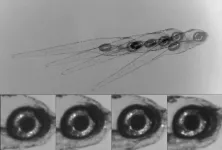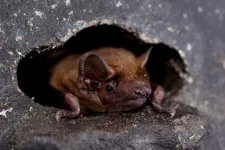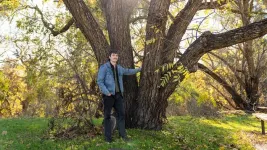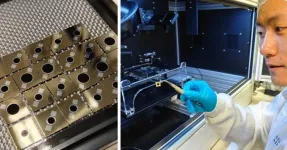(Press-News.org) NEWPORT NEWS, VA – For nearly half a century, Robert D. “Bob” McKeown has probed nuclear particles and educated rising generations of physicists. Now, the former deputy director for science at the U.S. Department of Energy’s Thomas Jefferson National Accelerator Facility is being honored for his outstanding career contributions with the 2024 American Physical Society’s Division of Nuclear Physics (DNP) Distinguished Service Award.
McKeown is recognized for his work in experimental physics and his extensive leadership in the broader nuclear physics community. Most recently, his leadership roles included serving on the Board of Directors of the American Physical Society (APS) and as speaker of its Council of Representatives.
DNP is a division of APS and comprised of scientists and educators who advance our understanding of the nature of matter down to the quarks and gluons that make up the constituent parts of nuclei and nuclear matter.
“I am very grateful to the DNP leadership for selecting me for this award,” McKeown said. “It has been a great privilege for me to be an active member of the nuclear physics community for now running on 50 years.”
Early in his career, McKeown contributed to the founding and mission of the Continuous Electron Beam Accelerator Facility (CEBAF), which became Jefferson Lab. Later on, he became its deputy director for science in 2010. That year, he was also named the Governor’s Distinguished CEBAF Professor at William & Mary in Williamsburg.
In retirement, he retains emeritus status at both institutions.
“A very important part of my career was teaching and the mentoring of young scientists,” McKeown said. “I supervised 14 Ph.D. students and over two dozen postdoctoral scholars, and many of these people have gone on to very successful careers in nuclear physics.”
In addition, he spent many years teaching and lecturing at the California Institute of Technology.
“There are now thousands of people around the world that I had some part in educating. Beyond the impact on science and technology, it has been great to get to know so many wonderful people,” he said.
Long Island to Jefferson Lab
McKeown grew up on Long Island, the son of an electronics technician in the aerospace industry who nurtured his interest in radio equipment and electronic circuits. In high school, those interests broadened to math, science and physics.
He attended Stony Brook University in New York, where a physics professor inspired him to focus on that field. While he pursued a doctorate at Princeton University, renowned physicist Gerald Garvey became his research adviser and mentor, providing excellent research opportunities to launch his career.
McKeown conducted much of his graduate research work at DOE’s Argonne National Laboratory in Illinois. His experiment there confirmed the weak interaction - or weak force - of the Standard Model of particle physics.
He earned his Ph.D. in 1979, then spent a year at Argonne before taking a position as assistant professor of physics at Caltech. He became a professor there in 1992.
Very early in his career, McKeown was tapped to join advisory committees for national laboratories, including summer study groups for Jefferson Lab in the early 1980s before the facility was even built. Once the lab’s main particle accelerator, CEBAF, was up and running, he was involved in designing early experiments, and for a while headed its user group. CEBAF is a DOE Office of Science user facility and is the research home to more than 1,650 nuclear physicists worldwide.
Eventually, McKeown was tapped by then-lab Director Hugh Montgomery to leave Caltech and become his deputy director for science.
At Jefferson Lab, he concentrated on administrative work, hiring talented people to move the lab forward and advance new mission concepts.
Among his accomplishments, strategic hiring to prepare the lab for its successful bid to lead efforts, along with partner DOE’s Lawrence Berkeley National Laboratory, to build a new $300-500 million High Performance Data Facility at Jefferson Lab.
He also initiated the Laboratory Directed Research & Development program to enable staff to pitch creative ideas to address critical national science and technology problems, and to enable the lab to respond more quickly to timely new opportunities. Now in its 11th year, the lab’s LDRD program recently awarded $3 million for more than a dozen projects in 2025.
And he formed a task force to study future accelerator upgrades at Jefferson Lab, including a new concept using the novel “fixed field alternating gradient” technology to potentially double the energy of the CEBAF accelerator.
A long way
From electron spin, to quarks and gluons, to ghostly neutrinos, nuclear physics has come a long way since McKeown first launched his career.
“When I began my studies of physics, we had evidence that protons and neutrons contained quarks, but there was no theoretical understanding,” he said. “But we soon saw the development of Quantum Chromodynamics (QCD) and have since established an elaborate and elegant theoretical framework, along with experimental techniques, to image the quarks and gluons inside protons and neutrons.”
McKeown has always had a particular fascination with neutrinos, and he counts his participation in neutrino experiments around the world as among his most memorable.
Neutrinos are subatomic particles with so little mass they pass undetected through matter at nearly the speed of light, earning them the nickname “ghost particles.” Even the most powerful detectors have difficulty finding and measuring them. They’re known to exist in three different states, or “flavors.”
“When I was a student, we had experimental evidence for neutrinos from nuclear reactors and particle accelerators,” McKeown said. “An underground experiment in South Dakota saw evidence that neutrinos were produced by the sun in nuclear reactions, but the number of them was too small. We have since established that the neutrinos have mass and can transform between the different flavors, which explains the solar neutrino anomaly.”
Two neutrino experiments in which he participated are standouts for him.
While at Caltech, McKeown and other American collaborators helped Japanese scientists build the KamLAND experiment in an underground facility in Japan.
“That actually showed for the first time that you could see the pattern of the neutrinos oscillating from one flavor to the other,” said McKeown. “And it all looked exactly like the theorists would predict, except we found that the amount of mixing that caused this effect was much larger than they would have predicted, so it was actually a surprise.”
The second breakthrough is the Daya Bay Reactor Neutrino Experiment, an international collaboration near Hong Kong, China.
“We measured the so-called third mixing angle in the neutrino matrix,” McKeown said. “That was very exciting, too, because this really cemented this theory of neutrino oscillations together. It provides the impetus for the new experiments that are being done today.”
As McKeown settles into retirement in California, he’s keeping his hand in the physics field with a new informal affiliation with Berkeley Lab and at the University of California, Berkeley.
“The goals of my work have always been twofold: producing scientific results and advancing the careers of young scientists,” he said. “I take great pride in the fact that I have been quite successful at achieving both of those goals.”
Further Reading
Robert D. McKeown, Experimental Physicist and Leader in National Laboratory Administration
Audio: Robert McKeown is interviewed by David Zierler for the Caltech Heritage Project
By Tamara Dietrich
-end-
Jefferson Science Associates, LLC, manages and operates the Thomas Jefferson Na?onal Accelerator Facility, or Jefferson Lab, for the U.S. Department of Energy's Office of Science.
DOE’s Office of Science is the single largest supporter of basic research in the physical sciences in the United States and is working to address some of the most pressing challenges of our ?me. For more informa?on, visit hMps:// energy.gov/science.
END
Robert McKeown recognized for a half century of distinguished service
Jefferson Lab Emeritus Deputy Director is honored with the 2024 DNP Distinguished Service Award
2025-01-02
ELSE PRESS RELEASES FROM THIS DATE:
University of Maryland awarded $7.8 million to revolutionize renewable energy for ocean monitoring devices
2025-01-02
University of Maryland researcher Stephanie Lansing received a Phase 1 $7.8M award from Defense Advanced Research Projects Agency (DARPA) to develop and test a biologically fueled energy source to power research and sensing devices throughout the world’s oceans.
There is a vast array of ocean sensing devices that provide critical information for understanding marine environments, monitoring climate change and maintaining national security. Many of these sensors are currently powered by long underwater cables or lithium-ion batteries.
Lansing is leading a large, collaborative effort that will overcome the need for batteries and ship-based or shore-based ...
Update: T cells may offer some protection in an H5N1 ‘spillover’ scenario
2025-01-02
Update: This LJI study was previously shared on bioRxiv in September 2024. Since then, health officials have reported a rise in H5N1 “bird flu” infections in humans, including the first severe H5N1 human case requiring hospitalization. Officials have also reported increased cases in feline species, including an outbreak among big cats at a wildlife sanctuary. In California, the recent spread of H5N1 to dairy herds in Southern California prompted Gov. Gavin Newsom to declare a “State of Emergency” on Dec. 18, 2024.
LA JOLLA, CA—New research led by scientists at La Jolla Institute for Immunology (LJI) ...
Newborn brain circuit stabilizes gaze
2025-01-02
An ancient brain circuit, which enables the eyes to reflexively rotate up as the body tilts down, tunes itself early in life as an animal develops, a new study finds.
Led by researchers at NYU Grossman School of Medicine, the study revolves around how vertebrates, which includes humans and animals spanning evolution from primitive fish to mammals, stabilize their gaze as they move. To do so they use a brain circuit that turns any shifts in orientation sensed by the balance (vestibular) system in their ears into an instant counter-movement by their eyes.
Called ...
Bats surf storm fronts during continental migration
2025-01-02
Birds are the undisputed champions of epic travel—but they are not the only long-haul fliers. A handful of bats are known to travel thousands of kilometers in continental migrations across North America, Europe, and Africa. The behavior is rare and difficult to observe, which is why long-distance bat migration has remained an enigma. Now, scientists from the Max Planck Institute of Animal Behavior (MPI-AB) have studied 71 common noctule bats on their spring migration across the European continent, providing a leap in understanding this mysterious behavior. Ultra-lightweight, intelligent sensors attached ...
Canadian forests are more prone to severe wildfires in recent decades
2025-01-02
Climate change is driving more intense wildfires in Canada, according to a new modeling study, with fuel aridity and rising temperatures amplifying burn severity, particularly over the last several decades. The findings underscore the growing impact of climate change on wildfire behavior, with the most severe effects concentrated in Canada’s northern forests. Fueled by ongoing climate change, Canada – one of the most forested and fire-prone regions in the Northern Hemisphere – is grappling with increasingly severe and prolonged wildfire seasons. ...
Secrets of migratory bats: They “surf” storm front winds to save energy
2025-01-02
A species of migrating bat “surfs” the warm winds of incoming storm fronts to conserve energy, according to a study that used tags to track the tiny animals on their long journeys across central Europe. The findings offer new insights into how weather, physiology, and environmental factors shape bats’ seasonal migration patterns. While bird migration is well-documented and studied, this is not the case for seasonal migration of bats – particularly the few long-distance, migratory species. These nocturnal travelers face substantial challenges, ...
Early life “luck” among competitive male mice leads to competitive advantage overall
2025-01-02
Early life "luck" plays a pivotal role in shaping individuality and success, particularly for males, according to a new study in mice. In male animals, competitive social dynamics amplified small initial differences into lifelong disparities in fitness. The findings highlight parallels between biological competition and societal inequalities and they demonstrate how chance events can drive divergent outcomes even among genetically identical individuals. Contingency (colloquially, “luck”) refers to the role of chance in shaping outcomes. It is a critical factor in both biological and social sciences, ...
A closer look at the role of rare germline structural variants in pediatric solid tumors
2025-01-02
Largescale changes in the genome inherited from parents are significant risk factors for pediatric solid tumors, such as Ewing sarcoma, neuroblastoma, and osteosarcoma, according to a new study. The findings, which highlight the role of germline structural variants (SVs) in early genome instability, provide new insights into the genetic underpinnings of pediatric cancers and open doors for improved diagnostic and treatment strategies. Unlike adult cancers, which often result from environmental factors or DNA damage built up over time, ...
Genetics of alternating sexes in walnuts
2025-01-02
The genetics behind the alternating sexes of walnut trees has been revealed by biologists at the University of California, Davis. The research, published Jan. 3 in Science, reveals a mechanism that has been stable in walnuts and their ancestors going back 40 million years — and which has some parallels to sex determination in humans and other animals.
Flowering plants have many ways to avoid pollinating themselves. Some do this by structuring flowers to make self-pollination difficult; some species have separate “male” and “female” plants. ...
Building better infrared sensors
2025-01-02
Detecting infrared light is critical in an enormous range of technologies, from remote controls to autofocus systems to self-driving cars and virtual reality headsets. That means there would be major benefits from improving the efficiency of infrared sensors, such as photodiodes.
Researchers at Aalto University have developed a new type of infrared photodiode that is 35% more responsive at 1.55 µm, the key wavelength for telecommunications, compared to other germanium-based components. Importantly, this new device can be manufactured using current production techniques, making it highly practical for adoption.
‘It ...
LAST 30 PRESS RELEASES:
Making lighter work of calculating fluid and heat flow
Normalizing blood sugar can halve heart attack risk
Lowering blood sugar cuts heart attack risk in people with prediabetes
Study links genetic variants to risk of blinding eye disease in premature infants
Non-opioid ‘pain sponge’ therapy halts cartilage degeneration and relieves chronic pain
AI can pick up cultural values by mimicking how kids learn
China’s ecological redlines offer fast track to 30 x 30 global conservation goal
Invisible indoor threats: emerging household contaminants and their growing risks to human health
Adding antibody treatment to chemo boosts outcomes for children with rare cancer
Germline pathogenic variants among women without a history of breast cancer
Tanning beds triple melanoma risk, potentially causing broad DNA damage
Unique bond identified as key to viral infection speed
Indoor tanning makes youthful skin much older on a genetic level
Mouse model sheds new light on the causes and potential solutions to human GI problems linked to muscular dystrophy
The Journal of Nuclear Medicine ahead-of-print tip sheet: December 12, 2025
Smarter tools for peering into the microscopic world
Applications open for funding to conduct research in the Kinsey Institute archives
Global measure underestimates the severity of food insecurity
Child survivors of critical illness are missing out on timely follow up care
Risk-based vs annual breast cancer screening / the WISDOM randomized clinical trial
University of Toronto launches Electric Vehicle Innovation Ontario to accelerate advanced EV technologies and build Canada’s innovation advantage
Early relapse predicts poor outcomes in aggressive blood cancer
American College of Lifestyle Medicine applauds two CMS models aligned with lifestyle medicine practice and reimbursement
Clinical trial finds cannabis use not a barrier to quitting nicotine vaping
Supplemental nutrition assistance program policies and food insecurity
Switching immune cells to “night mode” could limit damage after a heart attack, study suggests
URI-based Global RIghts Project report spotlights continued troubling trends in worldwide inhumane treatment
Neutrophils are less aggressive at night, explaining why nighttime heart attacks cause less damage than daytime events
Menopausal hormone therapy may not pose breast cancer risk for women with BRCA mutations
Mobile health tool may improve quality of life for adolescent and young adult breast cancer survivors
[Press-News.org] Robert McKeown recognized for a half century of distinguished serviceJefferson Lab Emeritus Deputy Director is honored with the 2024 DNP Distinguished Service Award




